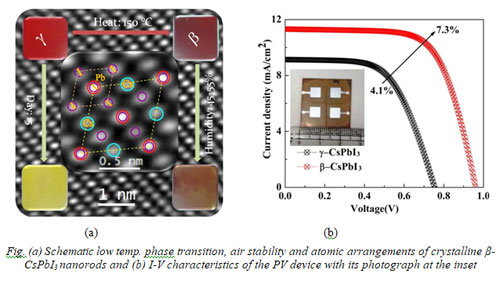 Scientist from S. N. Bose National Centre for Basic Sciences (SNBNCBS) an autonomous institute of the Department of Science & Technology, Govt. of India in collaboration with research group at IIT Kharagpur invented a new phase of inorganic perovskite materials which is highly photostable even under humid conditions and can make photovoltaic cells efficient and low cost.
Scientist from S. N. Bose National Centre for Basic Sciences (SNBNCBS) an autonomous institute of the Department of Science & Technology, Govt. of India in collaboration with research group at IIT Kharagpur invented a new phase of inorganic perovskite materials which is highly photostable even under humid conditions and can make photovoltaic cells efficient and low cost.The global threat of climate change forces us to look for alternate sources of energy that can limit CO2 emission. India harbours a huge potential for solar energy generation, and hence there is a need for efficient low cost photovoltaic (PV) technology.
Silicon (Si) based PV technology requires a higher cost of materials and processing temperature, restricting solar as an alternative to fossil-fuel-based energy sources. The efficiency of third-generation photovoltaic devices like organic solar cells and dye-sensitized solar cells (DSSCs), currently in use is relatively low and have long term stability issues, limiting their commercial use. The organic−inorganic lead halide perovskite solar cells (PSC) with low-cost solution-based processes and high efficiency are emerging as a worthy substitute, but have poor thermal and environmental stability owing primarily to the organic cation part. Scientists are now looking at all-inorganic perovskite materials as suitable alternatives.
Prof. Samit K Ray, Director S. N. Bose National Centre for Basic Sciences in collaboration with his research group at IIT Kharagpur invented a new phase of all inorganic β-CsPbI3 perovskite in its one-dimensional form, which has shown excellent photostability (resistance to change under the influence of light) under humid conditions and is also air-stable. Theoretically, it has been predicted that β-CsPbI3 can be crystallized at a lower temperature with higher stability, as compared to α-CsPbI3, but experimental realization has remained a challenge.
Prof. Ray and his group have used a novel, low temperature (150oC), colloidal synthesis process for obtaining a high-quality single-crystalline β -CsPbI3 nanorods and published it in the journal Advanced Energy Materials. The photophysical properties of β-phase has been found to be superior with an optical bandgap value better matched to the peak of the solar radiation incident on the earth. The fabricated PV devices showed around 12 % enhancement of the fill factor (a parameter that determines the efficiency of power conversion of a solar cell ) and the overall efficiency increase due to use of β-CsPbI3, was 78% in comparison to conventional γ-CsPbI3 phase.
The reported high-quality, single-crystalline β-CsPbI3 nanorod films not only underscore the performance of PV devices with moderately high efficiency but also provide highly stable, low-cost colloidal synthesis route of perovskite layers under 45–55% humid condition for potential use of photovoltaic and optoelectronic devices in future.
Publication link:
DOI: 10.1002/aenm.202001305
For more details, Prof. Samit K Ray (samit[at]bose[dot]res[dot]in, director[at]bose[dot]res[dot]in) can be contacted.






























